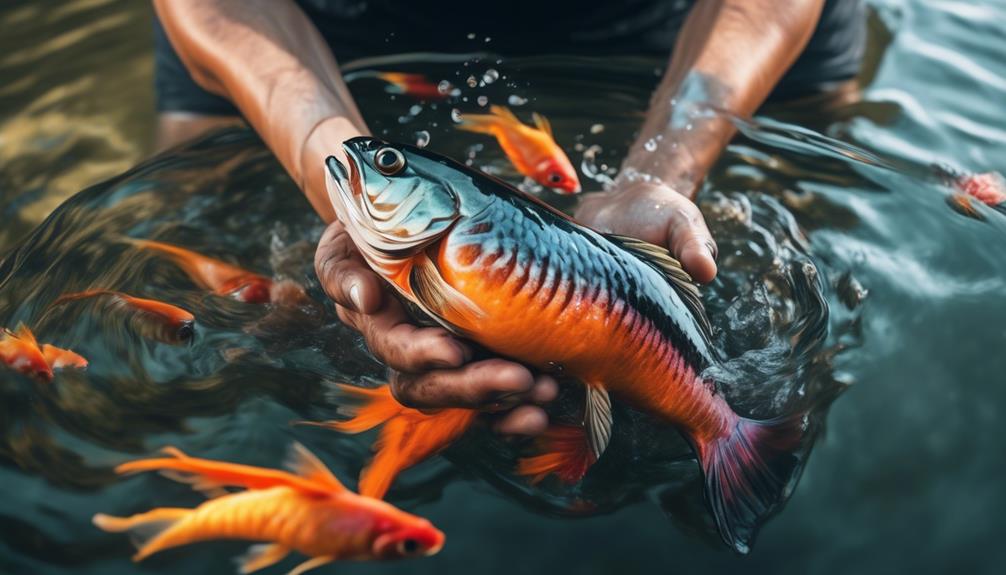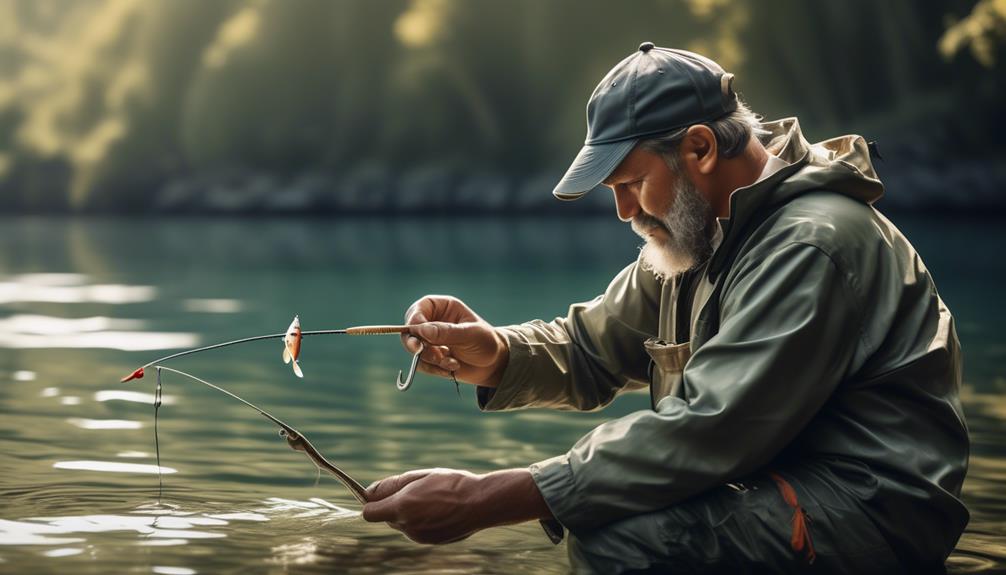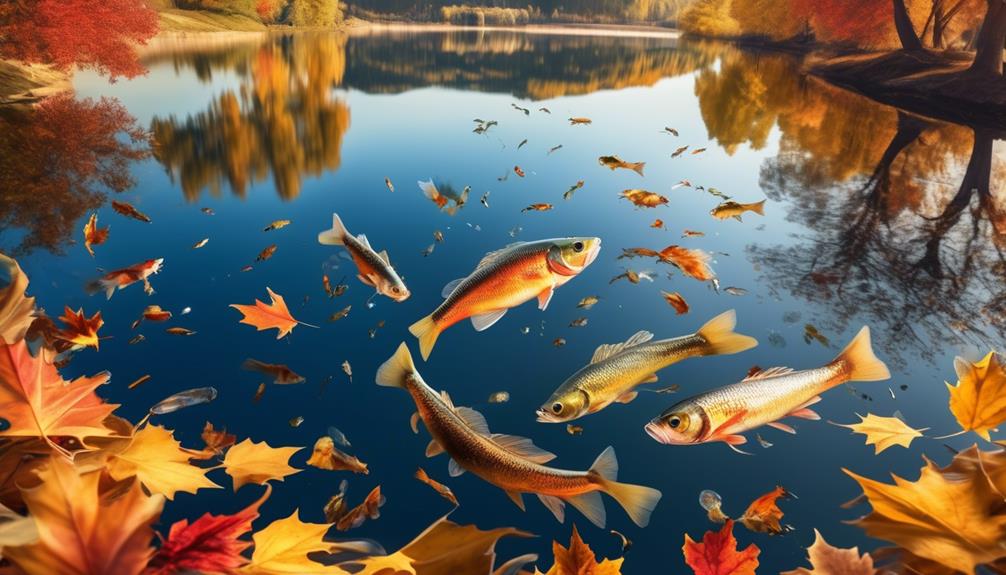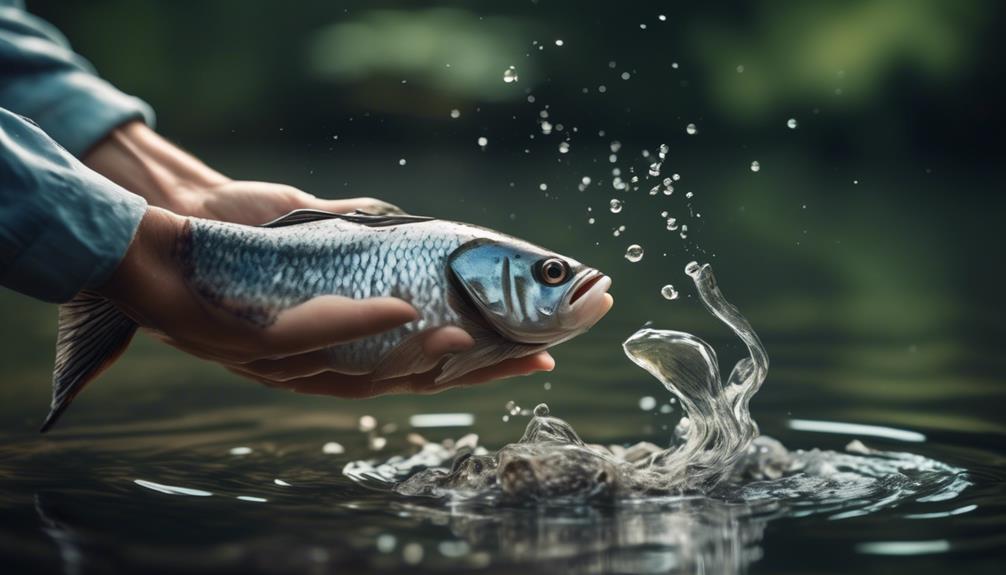When it comes to the delicate balance of preserving our natural world, catch and release is like a safety net for the intricate tapestry of ecosystems.
But why does it matter so much, and how does it truly impact the environment? The answer lies in the interconnectedness of all living beings and the crucial role that each species plays in the intricate web of life.
By taking a closer look at the benefits of catch and release, you'll gain a deeper understanding of its vital significance in the realm of conservation.
Benefits of Catch and Release
By releasing fish after catching them, you can help preserve the population and ensure the sustainability of the fishery. Angler participation in catch and release practices plays a crucial role in maintaining healthy fish populations. When anglers release their catch, it significantly enhances fish survival rates. This act of conservation not only benefits the current fish population but also ensures that future generations of anglers can continue to enjoy the sport.
When anglers actively participate in catch and release, they contribute to the overall health of the fishery. By releasing fish unharmed, anglers allow these fish to continue their natural life cycles, contributing to the maintenance of a balanced ecosystem. This conservation-minded approach helps in preserving the genetic diversity within fish populations, which is essential for their long-term survival.
Additionally, fish survival increases when anglers handle fish properly during catch and release. Using barbless hooks, minimizing air exposure, and handling the fish with wet hands all contribute to the fish's chances of survival after release. Proper techniques and awareness of best practices among anglers can significantly reduce the stress and potential harm to the fish, ensuring that they swim away healthy and strong.
Impact on Fish Populations
Maintaining healthy fish populations is directly influenced by anglers' practice of catch and release. This practice allows fish to continue their natural life cycles and contributes to the overall balance of the ecosystem.
By releasing fish back into the water, anglers help maintain the population dynamics of various fish species. This practice is crucial for the sustainability of fish populations and the overall health of aquatic ecosystems.
When fish are caught and released, their behavior is minimally disrupted. They can return to their natural habitats and feeding patterns, minimizing the potential stress and trauma caused by extended periods out of the water. This contributes to the overall well-being of the fish population, as they can continue their natural behaviors and life cycles without significant interruption.
Furthermore, catch and release practices directly impact fish population dynamics. By releasing mature fish back into the water, anglers allow them to contribute to the reproduction and growth of the population. This is particularly important for species with specific breeding or migration patterns.
Role in Preserving Biodiversity
Playing a crucial role in preserving biodiversity, catch and release practices allow for the conservation of various fish species and their habitats. By releasing fish back into their natural environment, you contribute to habitat protection and the maintenance of species diversity. When you release a fish, you're helping to ensure that its habitat remains intact and can continue to support a wide range of species. This has a direct impact on ecological balance, as different species within an ecosystem rely on each other for food, shelter, and other vital resources.
By maintaining species diversity through catch and release, you contribute to ecosystem resilience, ensuring that the natural environment can withstand and recover from disturbances such as environmental changes or human interference.
Through catch and release, you play a vital part in protecting the intricate balance of life within aquatic ecosystems. Every fish released back into its habitat contributes to the overall health and stability of the ecosystem. This, in turn, supports the preservation of various species and the overall resilience of the ecosystem.
Conservation of Endangered Species
Help protect endangered species by participating in catch and release practices, contributing to the preservation of biodiversity and the delicate balance of aquatic ecosystems. Endangered species protection is a critical aspect of conservation efforts, and catch and release plays a pivotal role in safeguarding these vulnerable populations. By releasing endangered fish species back into their natural habitats, you directly contribute to their survival and the overall health of aquatic environments.
Here's why conservation of endangered species through catch and release is crucial:
- Preservation of genetic diversity: Releasing endangered fish back into their habitats allows them to continue breeding and passing on their unique genetic traits, contributing to the preservation of genetic diversity within their species.
- Ecosystem stability: Endangered species often play key roles in maintaining the balance of aquatic ecosystems. By releasing them back into their habitats, you help ensure the stability and health of these ecosystems.
- Conservation of biodiversity: Every species, including endangered ones, has a part to play in the intricate web of biodiversity. By releasing endangered fish species, you actively participate in the preservation of biodiversity, which is essential for the overall health of the planet.
- Long-term sustainability: Through catch and release practices, you support the long-term sustainability of endangered fish populations, providing hope for their recovery and future existence. Your actions today can make a significant impact on the conservation of these precious species.
Ethical Considerations in Angling
Consider the impact of your angling practices on fish populations and their habitats to ensure ethical and sustainable fishing practices. Ethical angling practices are crucial for the welfare of fish and the long-term health of aquatic ecosystems. When engaging in angling, it's important to prioritize the well-being of the fish and minimize any potential harm caused during the process.
To ensure ethical angling practices, start by using barbless hooks, which can minimize injury and make it easier to release fish without causing unnecessary harm. Proper handling techniques, such as wetting your hands before handling fish to protect their delicate skin and avoiding squeezing them tightly, can also contribute to fish welfare. Additionally, using the right gear and tackle for the size of fish you're targeting can prevent overexertion and reduce stress on the fish during the catching process.
Furthermore, being mindful of the environment is a crucial aspect of ethical angling. Avoid fishing in areas with known vulnerable fish populations, such as spawning grounds, and be aware of any local regulations or guidelines regarding catch and release practices. By respecting these guidelines, you can help protect fish populations and their habitats, ensuring that future generations can continue to enjoy the sport of angling.
Influence on Ecosystem Health
Prioritize the well-being of fish and minimize potential harm caused during angling practices to positively impact the health of aquatic ecosystems. Catch and release practices play a crucial role in maintaining the balance of aquatic ecosystems. By releasing fish back into their natural habitat, you're contributing to the overall health of the ecosystem.
- Habitat Restoration: When fish are caught and released, they continue to play their part in the ecosystem by contributing to nutrient cycling and promoting the growth of aquatic vegetation. This, in turn, helps in maintaining the overall health and balance of the aquatic habitat.
- Population Dynamics: Catch and release practices help in maintaining healthy fish populations. By releasing mature fish back into the water, you're allowing them to reproduce and contribute to the sustainable population of fish. This ensures that the ecosystem's food web and ecological balance are preserved.
Scientific Support for Catch and Release
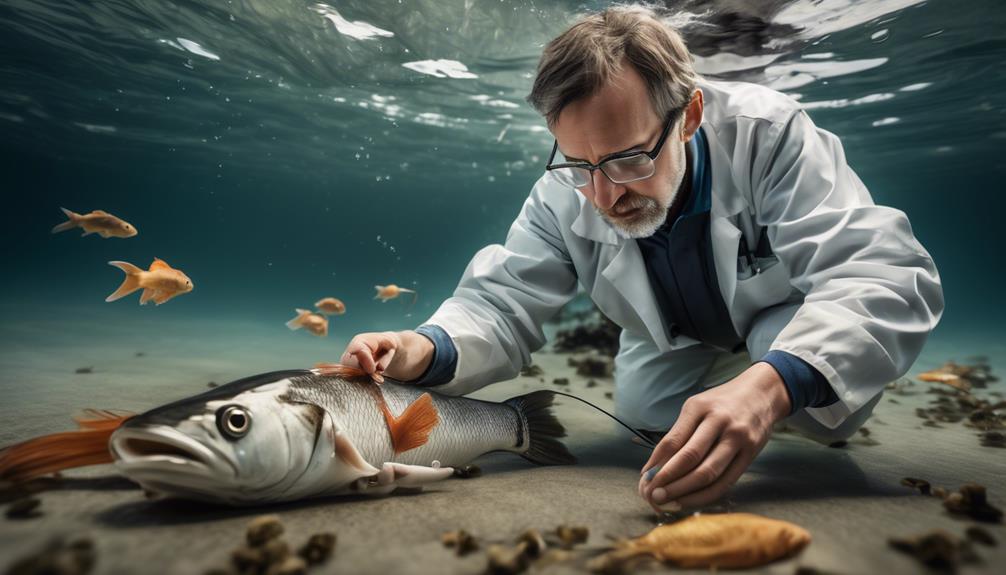
Indisputable scientific evidence supports the effectiveness of catch and release practices in maintaining sustainable fish populations and preserving the ecological balance of aquatic ecosystems. Understanding fish behavior is crucial in ensuring the success of catch and release. When anglers are aware of how different species behave when caught and released, they can take the necessary steps to minimize stress and injury to the fish.
For instance, knowing that certain species are more likely to jump out of the water when hooked, anglers can adjust their techniques to reduce the chances of the fish harming itself. This knowledge also helps in handling the fish properly, ensuring a higher survival rate post-release.
Angler education plays a significant role in the scientific support for catch and release. Educating anglers about the best practices for catch and release, such as using barbless hooks, minimizing air exposure, and avoiding deep hooking, can greatly improve the survival rates of released fish. Moreover, awareness about the importance of handling fish gently and releasing them quickly can lead to a positive impact on fish populations.
Scientific studies have demonstrated that when catch and release practices are done correctly, the mortality rates of released fish are low, contributing to the preservation of fish populations and the overall health of aquatic ecosystems. Therefore, promoting angler education is essential in ensuring the continued success of catch and release as a conservation practice.
Sustainable Fishing Practices
Understanding fish behavior and angler education are crucial for maintaining sustainable fish populations and preserving the ecological balance of aquatic ecosystems. This includes practicing sustainable fishing methods to minimize impact on the environment.
Sustainable fishing practices are essential for ensuring fish welfare and minimizing environmental impact. When engaging in recreational angling, it's important to consider the long-term implications and adopt sustainable fishing methods to support the conservation of fish populations and their habitats.
By doing so, not only do you contribute to the preservation of aquatic ecosystems, but you also ensure the continuity of economic benefits associated with recreational angling.
When practicing sustainable fishing, keep in mind the following:
- Selectivity: Choose the appropriate gear and techniques to target specific species, minimizing bycatch and preserving non-targeted fish populations.
- Catch and Release: Properly handle and release fish, minimizing harm and increasing their chances of survival post-release.
- Habitat Protection: Avoid damaging sensitive habitats such as coral reefs, seagrass beds, and spawning areas to safeguard the overall health of the ecosystem.
- Regulatory Compliance: Adhere to fishing regulations and size limits to prevent overfishing and support sustainable fish populations.
Frequently Asked Questions
How Does Catch and Release Support Local Economies and Tourism?
Catch and release has a big local impact, bringing economic benefits to communities. When anglers practice catch and release, it helps maintain healthy fish populations. This leads to more opportunities for fishing, attracting tourists and boosting the local economy.
With sustainable fishing practices, businesses like tackle shops, lodges, and restaurants benefit from increased tourism. By supporting catch and release, you're contributing to the prosperity of local economies and tourism.
What Are the Potential Long-Term Effects of Catch and Release on Fish Behavior and Reproduction?
Catch and release can impact fish welfare and conservation. Repeated catch and release can cause stress and affect fish behavior, potentially impacting their ability to reproduce. This could have long-term consequences for fish populations and their ecosystems.
Conservation efforts depend on sustainable fishing practices, so understanding the effects of catch and release is vital for ensuring the long-term health of fish populations and the ecosystems they support.
How Does Catch and Release Contribute to the Overall Health of Aquatic Ecosystems?
Catch and release is crucial for ecosystem health because it helps maintain fish population dynamics. When you release fish back into the water, it allows them to continue their natural behaviors and reproduction, contributing to a balanced ecosystem.
Are There Any Specific Regulations or Guidelines for Catch and Release in Different Regions?
In different regions, catch and release regulations vary, and enforcement plays a crucial role in maintaining healthy fish populations. Cultural differences and regional catch and release practices impact how these guidelines are implemented.
Some areas emphasize conservation, while others may prioritize recreational fishing. It's important to be aware of the specific rules and regulations in the area you're fishing to ensure you're following the proper catch and release practices.
How Can Anglers Ensure Proper Handling and Release Techniques to Maximize the Survival of Caught Fish?
To ensure proper handling and release techniques, it's crucial to prioritize fish survival.
As an angler, it's your responsibility to handle the fish with care, avoiding excessive handling and keeping it in the water as much as possible.
Use barbless hooks to minimize injury and always support the fish's body properly.
Conclusion
So, next time you're out on the water, remember that catch and release is crucial for conservation.
By releasing fish back into their natural habitats, you're helping to sustain fish populations, preserve biodiversity, and protect endangered species.
Plus, it's an ethical way to enjoy angling while ensuring the health of ecosystems.
With scientific support and a focus on sustainable practices, catch and release is a simple but vital way to contribute to the preservation of our natural world.
